Samsung S95B Reviewed at $1,999.00 (55")
Product Name: Samsung S95B
Product Description: 2022 4K QD-OLED TV
-
Design - 9.5/10
9.5/10
-
Video Quality - 8.9/10
8.9/10
-
Ports & Connectivity - 9.5/10
9.5/10
-
OS, Apps and Features - 9.3/10
9.3/10
-
Price / Quality - 9/10
9/10
Summary
Reviewed at $1,999.00 (55″)
Pros
- QD-OLED is better than all traditional OLED panels
- Great brightness
- Plenty of gaming options
- Tizen remains an excellent OS
Cons
- The TV aims to impress and not to create an accurate image
- No Dolby Vision support
- Color fringing may become noticeable
- No DTS
Cheapest Places to Buy :
*We are a reader-supported website. When you buy through links on our site, we may earn a small affiliate commission at no extra cost to you. Home Media Entertainment does not accept money for reviews.*
***June 7th Update***
It seems that Samsung has released a new firmware that fixes most of the problems that are described in our review. Unfortunately when this update was released we didn’t have the TV anymore to test it ourselves but from reports it is said that the S95B now has accurate EOTF tracking that was simply not possible before even with calibration.
It is good that Samsung tried to fix this but the fact remains that the S95B needs an update in order to make its image more accurate something that shouldn’t happen in the first place and surely a lot of consumers will be unaware of this fact. Hopefully our criticism will have impact on future releases and Samsung will be more careful when releasing such top premium models.
***
We are slowly preparing our new article containing all 2022 Samsung TVs but it’s this time of year that most new releases find their way to the markets and so we are happy to be able to test Samsung’s top flagship that surely will draw a lot of attention and not always for the right reasons. In our Samsung S95B review we are going to determine if QD-OLED is really as good as it is claimed and if Samsung’s entry into the OLED market is as the company envisioned it in the years before.

The S95B is the one of only two new TVs that will come with the new QD-OLED panel, the other being the Sony A95K which we plan on testing in the near future, so it is still very uncharted territory and with it being a first generation release it will surely improve in the years to come. But judging by Samsung Display’s initial claims about the new panel, these certainly look impressive and can put the QD-OLED TVs in a much better position than what current OLEDs are today.
But before we dive into our tests and further analysis let’s see what the Samsung S95B comes with. As we just mentioned it comes with a brand new 120Hz QD-OLED panel, and uses the updated Neural Quantum Processor 4K. For sound it has the Object Tracking Sound System along with Dolby Atmos support. It comes with four 48Gbps HDMI 2.1 ports, supports HDR10+ but not Dolby Vision and is equipped with Samsung’s latest Tizen OS.
It has been a long time we were waiting for Samsung to enter the OLED arena and it seems that QD-OLED is their main entry point. Is it as good as it seems and can the new S95B rise above what most top tier OLEDs have managed to achieve up to this point? Let’s start our analysis to find out…
Design
But before we start looking at the insides let’s talk about the S95B’s design. Being basically an OLED the S95B looks more alike to other OLED releases than any of Samsung’s previous units and this was to be expected.
This means that the TV comes with an exceptionally thin design that is characteristic of OLED with the electronics box being the only thick part extruding at the back. We measured overall thickness and the TV is an amazing 1.6″ (4 cm) thick making it look great on a wall.
Its black borders were also thin enough to make the screen look more immersive and this is a characteristic of most top tier releases. The back of the TV is the usual affair we see in most OLED models. This means that most of the panel is covered in metal keeping it sturdy while the electronics box is made of plastic and covers most of the lower half of the panel.
Most of the ports are placed at the left side of the back panel with some of them looking sideways while some look downwards. Strangely enough the headphones output has been separated from the rest and is found on the right side.
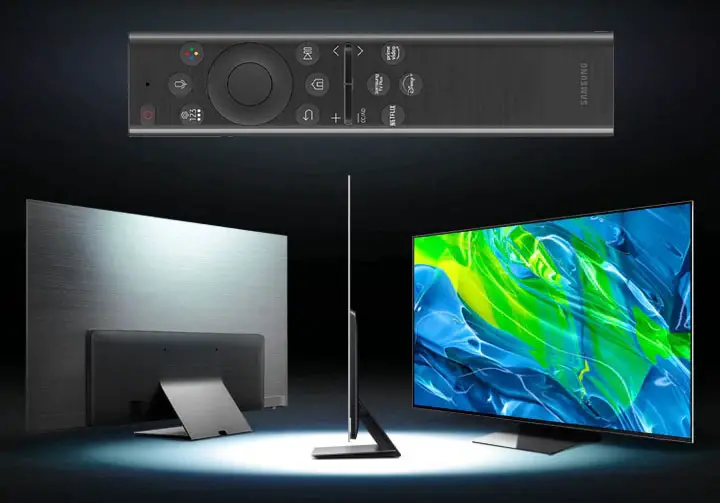
The TV uses a small central stand that is made out of metal. As a result the TV may wobble slightly, especially the bigger sizes so make sure it is placed in a safe position. At least with such a stand you don’t need to have a fairly large surface to place it on. With this stand the clearance between the screen and the surface is about 3″ which is more than what we had measured in our recent LG C2 review, meaning that most soundbars should fit under it without a problem. Just make sure to measure beforehand just to be safe.
As for its remote the One Remote that is included in the S95B looks similar to the year before but with some minor design changes. It is still small and uses very few buttons as it relies on the TV’s UI for most of its functions. It is still using a rechargeable battery that can be charged either through a USB-C cable or from its solar equipped back side. The only difference we find this year is that the top side is now seamless while a fourth dedicated button for Disney+ has been added.
Overall the S95B looks and feels like a premium model. It is well built, its thin design makes it look good and the stand and remote are carefully crafted. Everything you would expect from Samsung’s top offering this year.
Video Quality
Processor technology used
The new S95B uses new silicone named Neural Quantum Processor 4K. Unfortunately we don’t have detailed specs on this chip and if it is just an update of 2021’s Neo Quantum Processor 4K or something entirely new. But by judging from the marketing material it seems that this new processor is more of an update as we tend to find in these yearly releases.

What Samsung has mentioned about this new processor is that it uses up to 20 different neural network models, an update over last year’s 16, with each trained in AI upscaling and deep learning technology, in order for the processor to optimize picture quality to 4K picture output regardless of the input quality.
Also its Real Depth Enhancer feature automatically separates objects in the content from the background and created 3D like depth in order to make the image even more immersive.
Samsung still uses a lot of useless marketing terms in order to impress consumers but by judging last year’s processor we can say we have a pretty good idea what the new one can do.
During our tests of various resolutions and content material the S95B managed to upscale everything nicely. All content from low quality 480p up to 720p and 1080p resolution scaled to 4K without any noticeable artifacts due to the process.
In terms of audio we are going to talk in more detail in our dedicated section below but S95B’s processor allows for the use of Samsung’s Object Tracking Sound (OST) system along the rest of the included processing features.
Lighting technology used
The main strength of the S95B, and a major step forward in panel technology in general, is the use for the first time of Samsung’s Display QD-OLED panel.
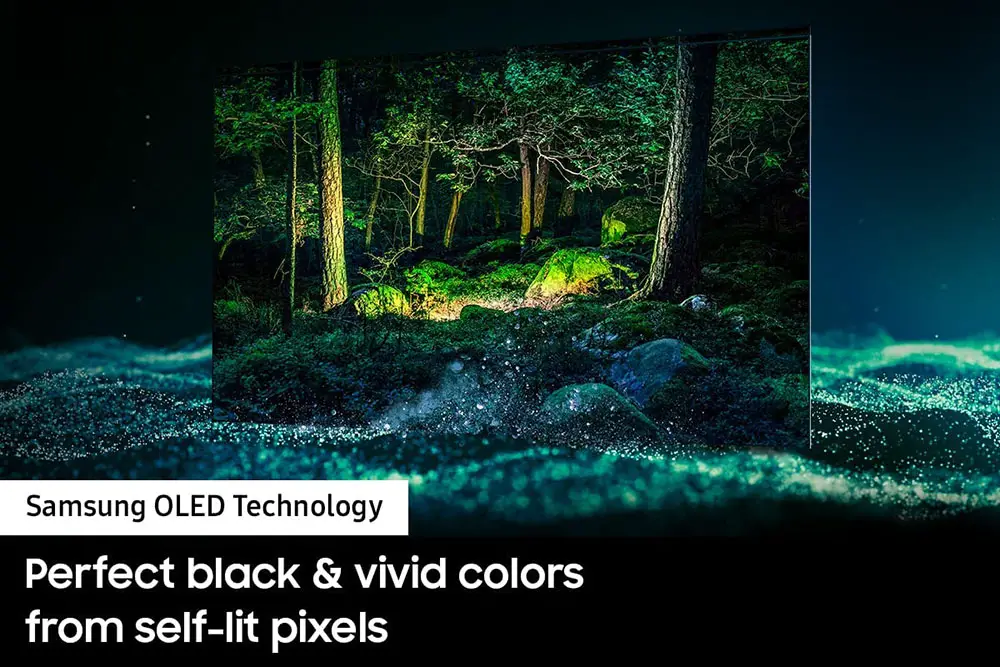
Traditional OLED panels feature self emitting pixels and as a result these TVs have no need for a backlight as we see in LED LCD models. Being able to control it’s individual pixels has many advantages with the most obvious ones being the extremely accurate light control and the infinite contrast they have with deep blacks being a sight that needs to be seen to be believed.
On the other hand the problem with OLEDs is that they cannot reach the high brightness output of LED LCD TVs. This has been a problem since the inception of OLED panels and although there have been some developments like Panasonic’s solution to add a heatsink in order to push the panel more without damaging it, OLEDs still remained a distant second when it came to peak brightness output.
And this is where QD-OLED comes into play as this hybrid design is meant to take all the strengths OLED has and with the use of Quantum Dot technology boost the brightness and color reproduction in levels that were not possible with the panels available till now.
We are not going to analyze very much how this technology works as this is a subject for another article but in theory the S95B, with the use of the new QD-OLED panel is meant to have superior brightness output, higher color coverage than any traditional OLED panel so far, better viewing angles and better image reflection handling. All these in theory, but it is interesting to say the least the leap in performance this panel promises to offer.
As far as the S95B in particular, if there is one thing we noticed during our time with it is that due to the unusual subpixel structure of QD-OLED you may notice some green or red lines in content that have black bars on top or bottom of the screen. Also due to this, using the S95B as a PC monitor may not have the most clear text among the top tier models.

QD-OLED seems to be the future when it comes to OLED. And with this being the first generation of products things surely can look even better in the coming years making us very excited of what is to come.
Brightness / Contrast
Obviously due to the use of this new QD-OLED panel our brightness tests gather most of the attention and not without reason. So without delaying any longer let’s see what we came up with.
First test here is the SDR brightness over a 10% window and the number we got was 502 nits which is good and will suffice for any kind of SDR content even though it still is a far cry from the output of previous flagship models like the QN90A.
When it comes to HDR brightness over a 10% window we measured 1040 nits which is really good even if it still not on the same level as some LED LCDs. Peak brightness seem to be able to reach about 1,500 nits but this cannot be sustained for long and peak levels will go down over time.
As with all OLED TVs, the S95B comes with an Automatic Brightness Limiter (ABL) that lowers the overall brightness of the screen when large parts of it become very bright. This may not be very obvious when watching a movie for example but it can be noticed more with bright static images or if you use the TV as a computer monitor.
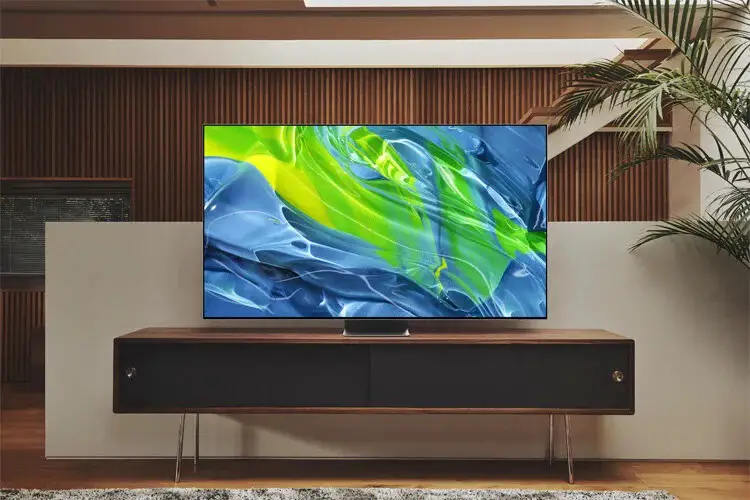
Now, another thing that we noticed is that the S95B is a bit cheating when measuring its brightness output. When we take our measurements we do it at the industry standard of 10% window size and with this size the S95B seemed to follow the target luminance level very faithfully.
But even so in real world content the image looked brighter than it should and there has been a lot of talk in forums about this. This made us take measurements in other sizes other than the 10% window that we use almost always and what we discovered was that the brightness output was higher than the reference target and this was the reason for the more bright image we were seeing.
In essence the S95B was brighter than what it should be and although the image may seem more impressive to the eyes of many it surely was not as accurate as it should be.
To make things even worse when trying to adjust settings to bring the brightness closer to the EOTF reference values we still couldn’t get it right as the S95B would boost the highlights and crash shadows in order to make the image look more impressive than it should be, meaning less accuracy in the end.
Closing this part of our review what we can say is the what Samsung seems to have done is that they tried to create a wow factor in order to show the S95B’s image output as more impressive than it should be and they did that at the expense of image accuracy. If this is the right thing to do or not we leave it up to you to decide.
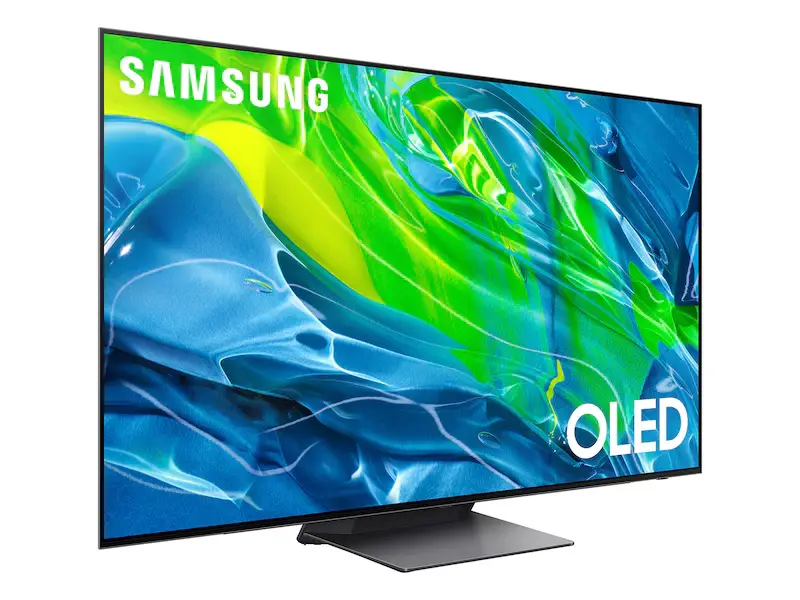
Viewing angles
OLED TVs always had the upper hand when it came to viewing angles and it seems that with QD-OLED things got even better. To be honest here, while we do like that QD-OLED managed to push the viewing angles to even better values this was never a real problem to begin with so from all the advantages this new panel has maybe this one is the most minor one.
In general, light has a linearity, so when viewing a display, it affects the brightness or color depending on which angle you look at the screen. With the characteristic of QD-OLED that emits light uniformly in all directions, the QD display provides optimal image quality by delivering uniform luminance and color regardless of viewing angle.
As a result the S95B was able to exceed viewing angle levels with unaffected image quality levels compared to all traditional OLED TVs we had seen until now. Even at extreme angles of up to 70 degrees the image properties of the S95B were almost the same as watching the TV dead center which was impressive to say the least.
This makes us give the S95B the title of the TV with the best viewing angles up to this day and surely this is an area where the new QD-OLED technology is far superior to anything else out there at the moment.
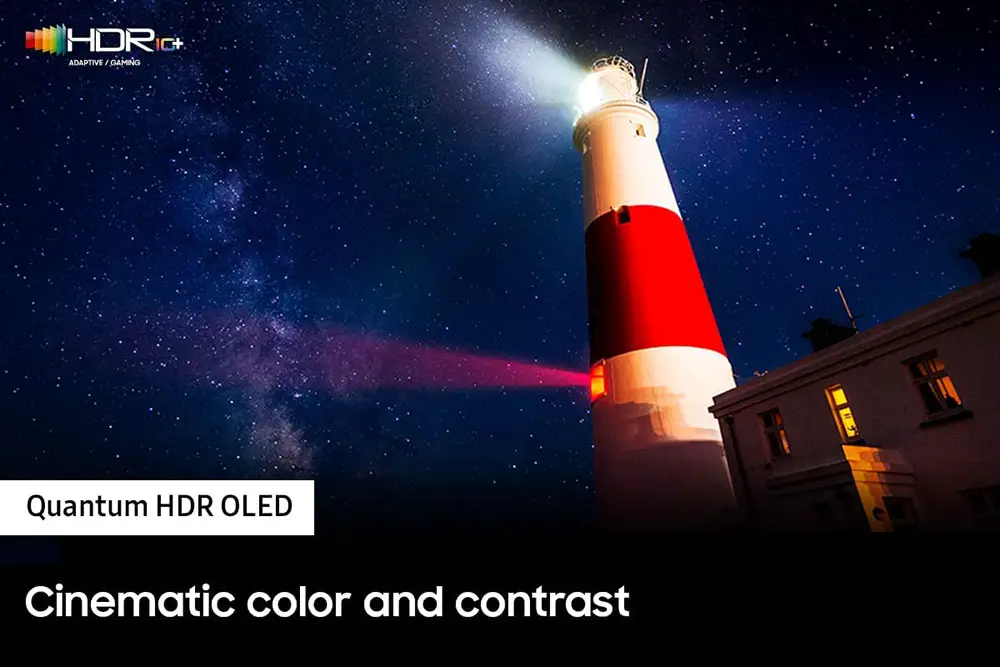
HDR support
HDR support is another area where Samsung hasn’t changed anything for 2022. As such we get the most basic HDR10 that is required for 4K UHD playback, there is HLG that is used mainly for broadcasting along with the newer HDR10+ which is the most advanced HDR protocol that uses dynamic metadata in order to provide the best image quality on a frame by frame basis, similar to what Dolby Vision is doing.
The S95B comes also with HDR10+ Adaptive and HDR10+ Gaming. HDR10+ Adaptive uses its AI engine to analyze the viewing environment, including the lighting, brightness and even reflections using the sensors equipped on the TV. The results are then incorporated into the dynamic metadata, and then through four further steps, the brightness and contrast of a scene are optimized. This way you can view HDR10+ movies and television programs in various environments at home.
Samsung continues to say no to Dolby Vision and this is one of the low points this TV surely has. Samsung remains very confident supporting HDR10+ instead but in our opinion this is a pointless conflict and all manufacturers should embrace all HDR formats instead of pushing consumers to choose by brand because of this.
Color coverage
Next comes our color measurements and here things are a bit similar to what we mentioned in our brightness test. But before this lets measure color coverage and here the S95B did admirably. The TV can cover the full 100% of the DCI-P3 color space and in the wider REC.2020 we measured 89% coverage.
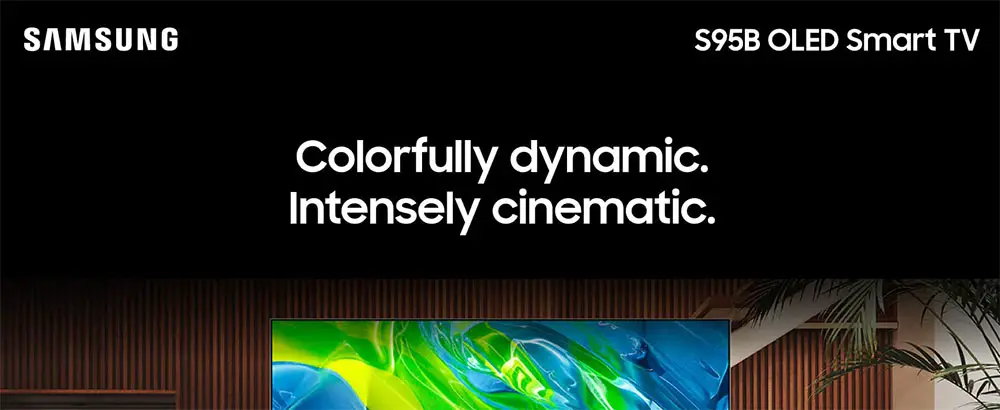
These numbers are spot on to what Samsung Display was claiming for their QD-OLED technology and surely they have delivered on their promises.
But here again we find that the S95B is not behaving in a way that would make the image accurate but rather aims for an wow factor by over-saturating colors in order to make them appear more impressive and less accurate.
Again in a similar manner to when we took our brightness measurements, when measuring a 10% window color accuracy was great and all colors had values well below the DeltaE limit of three. But when measuring different image sizes that are not so much industry standard then color errors went all over the place. And this happened with Filmmaker mode that is supposed to be the most accurate of them all.
What does all of this means? It means that the S95B is boosting color luminance in order to make the image look more impressive which impacts the accuracy of the colors. So in essence the S95B may look like it has colors that pop more, but surely are not as accurate as creators intended.
Color gradients were excellent and we didn’t notice any banding across any of the color shades. There is also a Noise Reduction function in case banding is visible but we don’t think it will be needed as the S95B did brilliantly here.
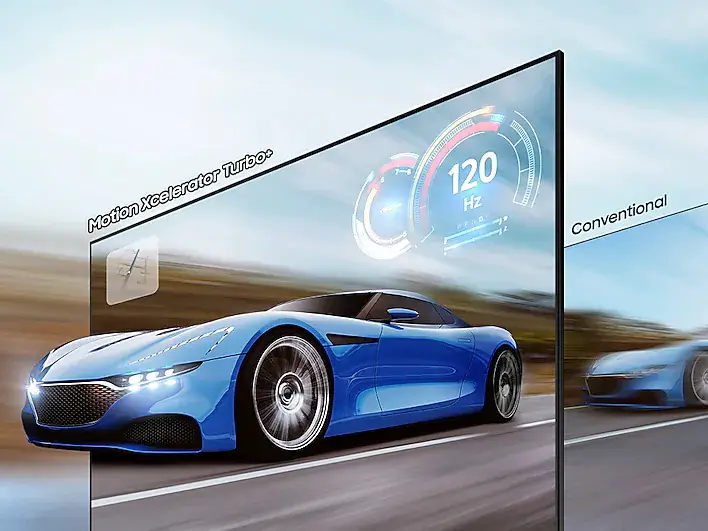
Motion performance
When it comes to it’s motion performance the S95B behaved really close to what we had observed in many others top performing OLED TVs. Samsung has included what they call Motion Xcelerator Turbo Plus along with a 120Hz panel. But being an OLED it doesn’t need a backlight to light its pixels and while in theory this makes the S95B flicker free in reality this is not the case but the flicker is so small that is not visible to the naked eye.
The TV also comes with the usual Motion Interpolation features that can smooth motion and remove blur and judder from fast camera movements. Motion interpolation did a good job overall as we noticed only minimal artifacts from the process and these were mostly due to the very fast camera moves depending on each scene.
Obviously using very aggressive settings will make the familiar “Soap Opera Effect” to appear so you have to adjust the settings accordingly. Enabling motion interpolation can be done by going in the Picture Clarity settings in the menu and by adjusting the two sliders for blur or judder you can set them according to how you like it.
Black Frame Insertion (BFI) is also available as usual which can be enabled in the menu with the Clear Motion option. BFI is a technique that inserts a black frame in between two individual frames in order to smooth out motion. Although the end result is very good it has a couple of side effects. First due to the black frames brightness takes a visible hit while due to the lower frequency used, as it can flicker only at 60Hz, some flickering may become noticeable.

Overall the TV did very good here. We didn’t notice any abnormal behavior and all content showed great and similarly to other top performing OLEDs.
Input lag
The last few years manufacturers push the envelope more and more when it comes to their TVs input lag performance and we have reached a point where we get amazing low values that can make these TVs excellent for gaming purposes.
According to our measurements the S95B measured an average of 9.3ms input lag in both 1080p and 4K resolutions at 60Hz with the use of the Fastest Input Lag option when in Game mode. At 120Hz we measured 4.9ms in both 1080p and 4K resolutions which is one of the lowest input lag measurements we have seen and actually is the same as what we measured in our recent review of the LG C2.
With such low figures, gaming can really be a pleasure but in order to get such a low value you have to keep in mind that you need to use the available Game mode as outside that the input lag will greatly increase to around 68.7ms which can still be used in slow paced offline games but it is too much for online gaming that requires blazing fast response times.
We should also not forget to mention that the TV supports Auto Low Latency Mode (ALLM) that can be used with any devices that support that like the PS5 and Xbox consoles and can greatly benefit users. Once again we get HGiG Mode which is HDR Gaming Interest Group’s technology that ensures you enjoy HDR games the way that their creators and developers intended. In order to activate it you need to enable the Game HDR setting in the HDR Tone Mapping menu.
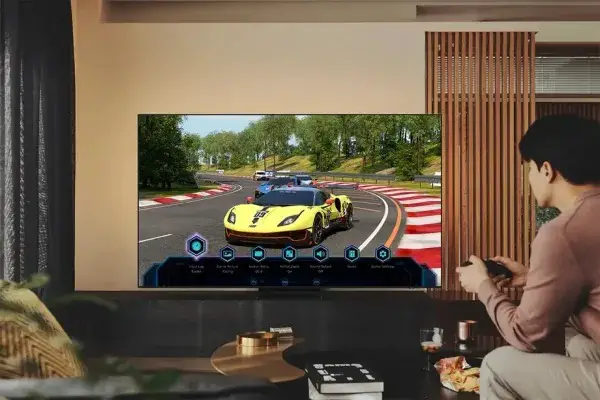
The S95B comes with support for all VRR technologies including HDMI Forum VRR, AMD FreeSync and NVIDIA G-Sync and can be enabled in the Super Ultrawide GameView & Game Bar which now is named as Game Bar 2.0.
Another interesting aspect of the S95B is that it can support high frame rates up to 144Hz although this is not officially claimed by Samsung. Obviously with next generation consoles like PS5 and Xbox series X supporting only 120Hz this feature can be used for the moment only with a computer.
A couple of things that we noticed when enabling 144Hz is that the S95B allows this high frame rate along with 4K resolution and HDR but on the other hand you cannot choose anything else other than 8 bit color depth no matter what chroma resolution we would choose.
One feature that is pending release through an update is Samsung Gaming Hub through which you will be able to use gaming services like Google Stadia and GeForce Now. There is not a definite date on when this will be released or in which markets this will be available so we are still waiting on further updates.
Before we close this part of our review we connected our PS5 and tried a bit of Call of Duty Vanguard. Our session was as smooth as you would expect and showed us that the S95B can be an excellent gaming TV with fast response times and low input delay that could elevate your gaming experience.

Image quality impressions
The S95B is like a coin with two opposite sides really. On the one hand the use of the new QD-OLED display gave the TV the ability to go above and beyond what was possible with traditional OLED panels up to this moment.
This means that what we have here is superior brightness output, higher color coverage, better viewing angles and support for higher refresh rates. Samsung Display had promised all these and they indeed delivered.
On the other hand the S95B, despite having all these advantages, it tried to create an image that is less accurate and more breathtaking in order to convince consumers of its superiority which in reality didn’t need to do. As a result images look brighter than they should and colors are oversaturated making them feel more impressive but surely less accurate.
What makes things worse is that when taking measurements on industry standard settings like a 10% window, the TV will show appropriate and accurate measurements but when trying some size outside the norm it is when the S95B really goes bananas. Also trying to calibrate the TV into correct output it still presented inaccurate brightness output compared to the reference target with overblown highlights and crushed shadows in order to present a more “impressive” image.
Some may like this look of the S95B but what is the point of creating such an advanced panel if not to create the most accurate image possible exactly as their creators intended? We only hope that in the future this extraordinary panel will be utilized in the correct manner and we will see TVs that try to respect more accuracy than impressing consumers with inaccurate images no matter how good these may seem.
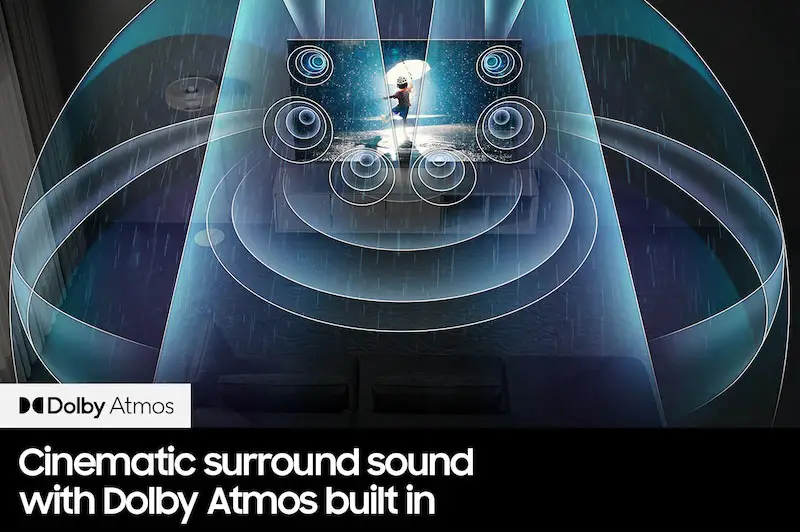
Audio Quality
If there is one area that manufacturers are still struggling with after so many years is in the audio department. These ultra slim TVs simply don’t have the space required to equip them with audio systems capable at offering more immersion and better sound. We have seen most TVs lately incorporating various techniques and features but most of them are mostly software based and the end result is not much better than what we were hope for.
It’s been a few years now that Samsung has developed their own audio system for their top flagships called Object Tracking Sound and as of 2021 there are four variants of this system depending its capabilities. We have the OTS Pro, OTS+, OTS and OTS Lite and for the S95B Samsung has used the OTS variant which is exactly the same as the system we had seen last year in the QN85A.
As such the S95B features a 2.2.2 channels audio system with a power rating of 60 watts in total which is more than enough for casual viewing. The difference compared to the OTS+ is that the latter uses 4.2.2 channels instead making the sound feel more accurate when tracking what is on screen.
The drivers used in the S95B are placed at the back of the panel and certainly didn’t have the volume and immersion we had experienced in the OTS Pro system before.
The TV supports Dolby Atmos but even with a system like OTS you shouldn’t have high hopes in terms of audio immersion and surround sound. If you want to get the most out of it then you will certainly need a dedicated audio system or at least a soundbar with surround speakers. Dolby Atmos can be passed-through the included eARC to some Dolby Atmos soundbar or dedicated sound system in this case.
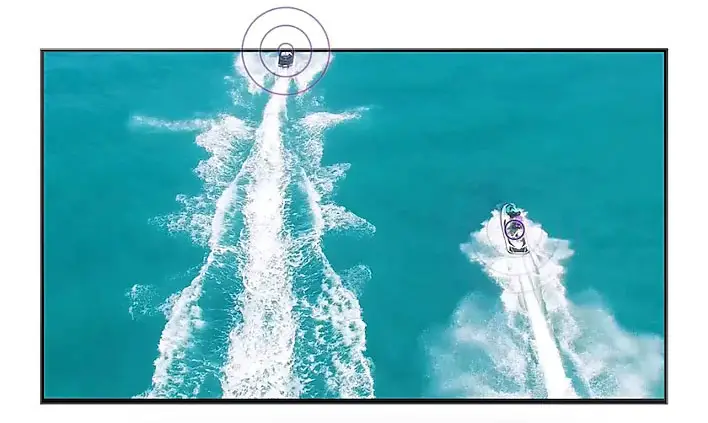
DTS support is completely absent once again as it is not only missing from native support but it cannot also be passed-through from any of the available ports which is rather disappointing. If you want DTS then Sony is the only of the big three that still supports it in their new releases so keep this in mind also.
The S95B also comes with some added features we had encountered previously. The first one worth mentioning is called Adaptive Sound+ with which the TV analyzes the content being played and for each scene can identify and render the best sound type. This whole process starts by separating and classifying audio input signals. Key characteristics are then pulled out and rendered to best suit the scene.
Another feature is Active Voice Amplifier (AVA). By using AVA the TV can detect environmental noise and enhance the voice output of the content you watch for a more pleasant viewing experience.
Lastly we get Q-Symphony which is a feature that you can use to combine the TVs audio system with an appropriate soundbar that also supports that. This way the audio will be synced and output from both devices for an even more immersive audio experience. Samsung has released a whole lineup of soundbars that support this feature in case you are thinking of getting one.
Audio remains one of the least interest aspects of these new TVs. As good as the image is in these new panels the audio still remains a bit of an afterthought so if you plan on using this TV in a home theater or entertainment area then a soundbar or some short or a dedicated surround system is highly recommended.
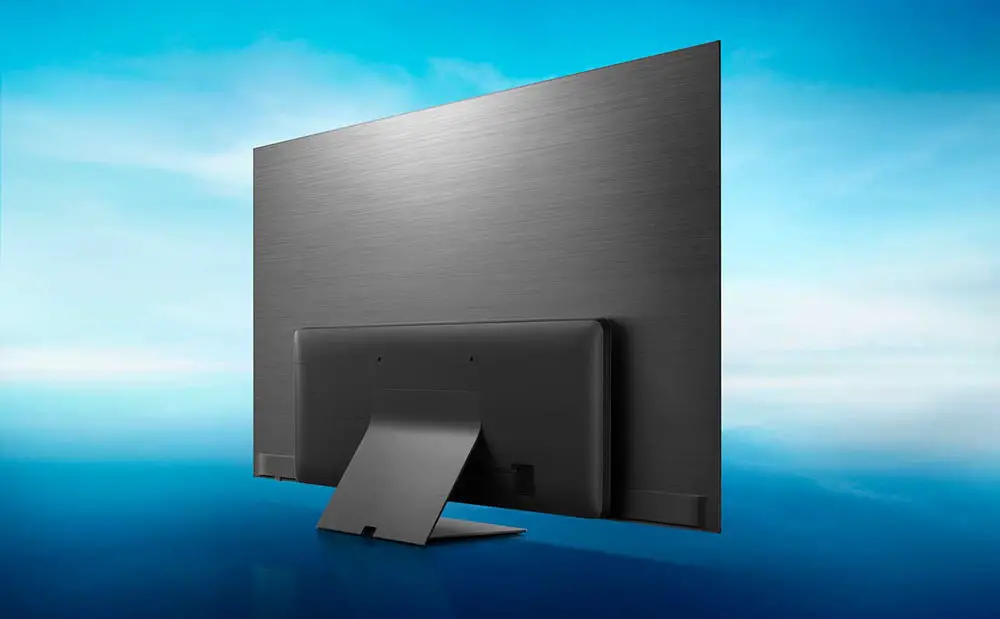
Ports and Connectivity
The S95B is using a new ports layout from what we have been used to in many of their recent releases. The One Box seems to become obsolete which is a pitty really and so we find that all ports are incorporated into the main body of the TV itself like LG and Sony have been doing all these years.
Starting from the top right we find two USB ports and two HDMI ports. With those looking downwards we find another two HDMI ports, a digital audio optical output, a LAN port for connecting to your local network, an Ex-Link port and the usual antenna/cable port. Strangely, as we mentioned above, the headphones port is placed on the right side completely isolated from the rest.
All four HDMI ports are version 2.1 with 48Gbps of bandwidth due to the use of Samsung’s own SoC unlike Sony that still has to rely on MediaTek chipsets with all the problems these have.
The HDMI ports being v2.1 means that they support all new and old features including 4K@120, ARC, eARC, ALLM, VRR, G-Sync, FreeSync, HFR and HDMI-CEC.
Lastly the Ethernet port for one more year will only support up to 100Mbps which is a real shame but not entirely surprising given the fact that all manufacturers still include 100Mbps adapters in their TVs. We don’t believe that upgrading these ports to Gbit speeds would up the cost so much and with streaming requirements increasing every single year this change should have been made some time ago. Let’s hope that manufacturers will take notice of this sooner rather than later.
And since we talked about online the Samsung S95B comes with upgraded wireless capabilities as it now supports WiFi5 (802.11ac) along with Bluetooth 5.2.
OS, Apps and Features
Being a Samsung TV means that for its OS we find the usual Tizen platform which has been updated to its 2022 version. It seems that Samsung decided to follow Google and LG and made the new Tizen occupy the whole screen instead of being a tile based row at the bottom of the screen, exactly as Google TV and webOS are this year.
It seems that smart TV platforms opt for a more personalized experience and as such the new Tizen 2022 tries to provide you with options that are tailored for your viewing habits. As such there are personalized ads, recommendations based on your viewing patterns both for streaming services and broadcasting channels and even shopping suggestions.
If you have used Tizen before, the new version may feel a bit chaotic at first. This was the same with Google TV and webOS and certainly you will need to spend some time with it to get your bearings. But once you get the hung of it, it is easier to navigate than it may seem.
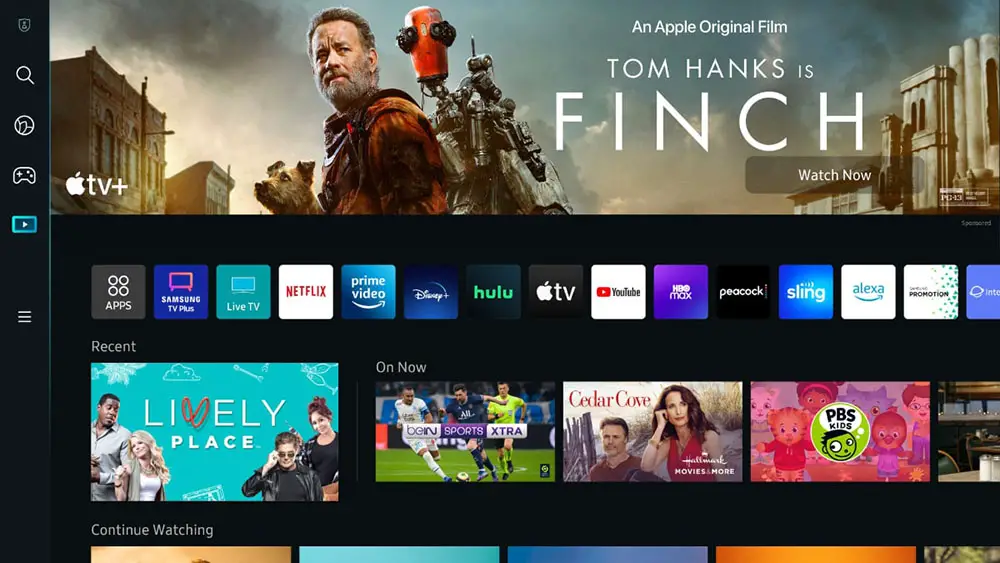
The new Samsung Smart TV Hub is separated in different sections and it allows you to navigate easily through all of them. At the left of the screen there is a single column with a few central selections while the rest of the screen is divided in rows with streaming services, apps and other functions and features available.
Having tried both the latest Google TV and webOS we can say that the new Tizen is not all that different. Obviously the layout is tailored to Samsung’s needs but in essence it offers the same thing. Navigation was smooth enough and jumping from one app to the other was relatively fast and with no obvious lags or delays.
Except from the visual overhaul the new Tizen comes with a few updates although fundamentally it offers the same kind of functionality we had experienced last year.
The Super Ultrawide GameView & Game Bar that was introduced last year makes a return but now it is called Game Bar 2.0 and got an update along the way. This is an on-screen menu that lets you make real-time adjustments to screen ratio, input lag check, FPS, HDR, wireless headset settings and more. This can be a really handy feature to gamers as you don’t have to mess with menus every time you want to check on a specific setting. With this quick feature you have everything in front of you with the click of a button.
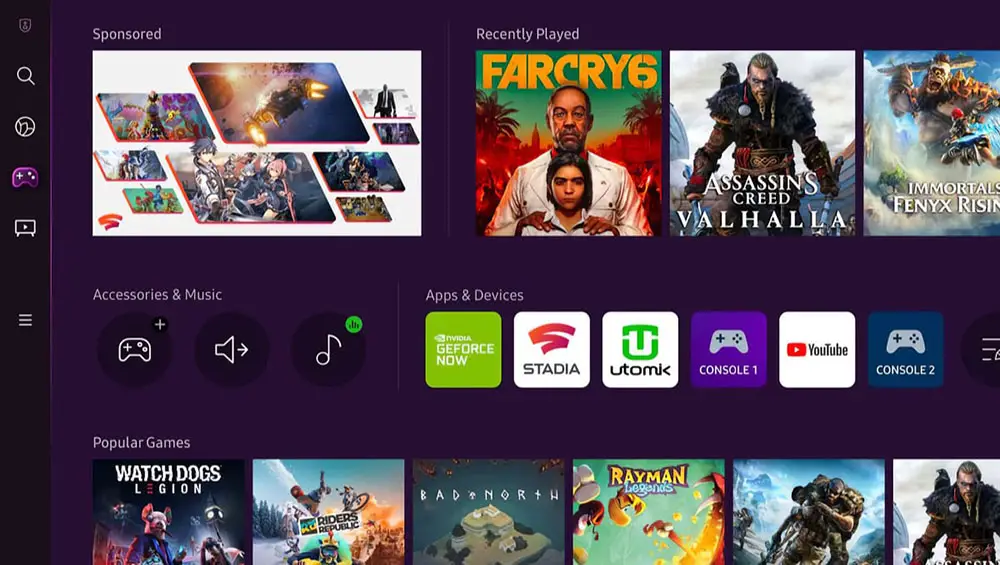
When it comes to content the Tizen platform is famous for it’s enormous support from developers. The S95B offers practically all known services and platforms you can think of with Netflix, Apple TV, Disney Plus, Youtube, Amazon, Hulu, Rakuten, Demand 5 and BBC iPlayer just a few of the big names available. There is also Samsung TV plus which offers hundreds of subscription-free channels to choose from. Many of these services can playback in both 4K with HDR like Netflix and Amazon but this very much app dependent.
A function that has been retained from the last few years is SmartThings integration. With it you can make your TV the central hub of all your smart houses devices. These can be lights, electronic locks, alarms, vacuum robots, thermostats and everything that supports the SmartThings platform.
Obviously another feature that could not be missing is voice control. It seems that Samsung is really trying to market their own Bixby service but even if you are not very fond of that there is Amazon’s Alexa or Google Assistant to choose from. While if you are an Apple guy then don’t get disappointed as there is also Airplay 2 support and you can use Siri through it for your voice commands. Unfortunately while Airplay is available HomeKit is not.
Another feature that was introduced a couple of years ago and seems to be a standard now is Multi-View and although at it’s core it’s not something entirely new Samsung took it a step further. Multi-View is basically a more advanced screen mirroring and with it instead of just simply projecting the screen from your mobile device on the TV you can choose to have two screens showing both TV content and what your mobile device shows.
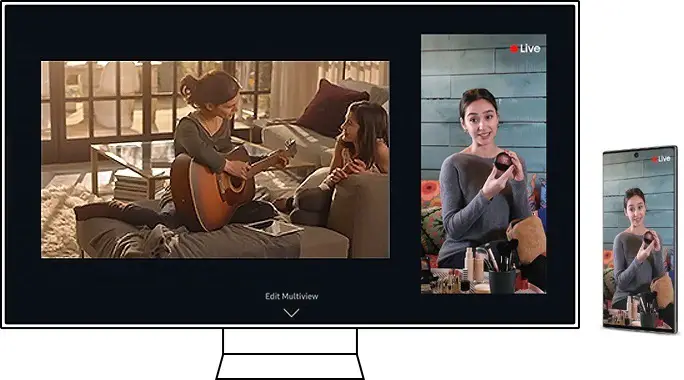
In addition to Multi-View there is also Tap View and with it you can mirror your phone on your TV with just a tap to continue enjoying movies, music, and apps on the bigger screen within seconds.
Another returning feature is Ambient Mode+ which is a slightly enhanced version of the Ambient Mode we get in many Samsung models for the last few years. With the plus version now except from the ability to display various images on the TV when not in use it can also project various information including weather updates, news headlines, photos and music.
Samsung Health is another returning feature from last year. Last year with the coronavirus pandemic many people were staying indoors so Samsung thought that exercise at home would be on the rise. So many of their TVs came with Samsung’s program in order to stay in shape. It seems that Samsung liked it so they kept it in for another year.
Overall there are not many additions or changes other than the visual overhaul of Tizen. The OS still offers the same functionality but in a different package and while it may take some time to get used to the new design after some time with it you will not even be bothered by all these menus and clatter because you will know where you want to go in a heartbeat.

Final Thoughts
The S95B will surely be the subject of heated debates. On the one hand the TV has all the ingredients to be an excellent premium model and the QD-OLED technology seems strong even at its first generation. But even so Samsung opted for impressing the masses than giving us a TV that can create images as their creators intended.
Obviously there will be a lot of consumers that will not be bothered by the fact that the impressive images the S95B can produce are not in reality as accurate as they should and as long as they look good to their eyes they will be fine with their option. And this is totally fine. But it is a shame when the S95B has everything it needs in terms of hardware not to be utilized in the right way.
In all these years we are making reviews this is probably the first time we were troubled with what score to give to a TV for its image quality. Do we score it high due to the undoubtedly impressive images it can create or score it low due to the inaccurate output that aims more to impress in order to sell more units. In the end we decided to settle somewhere in the middle and we would advise you to read our full analysis in order to make up your mind.
Closing our review we can say that the Samsung S95B has a lot of good things going for it. It may not have the most accurate image output but there is so much more to a TV than just how accurate is the brightness and the colors and it would not be fair for the S95B to be thrown in the dumpster just for this. Its overall peak brightness and colors, deep blacks, extremely low input lag, excellent viewing angles, Tizen and full gaming features along with four HDMI 2.1 ports are just a few of its strengths.
And just for these we are sure that in the end there will be a pretty big market that will embrace it no matter what.
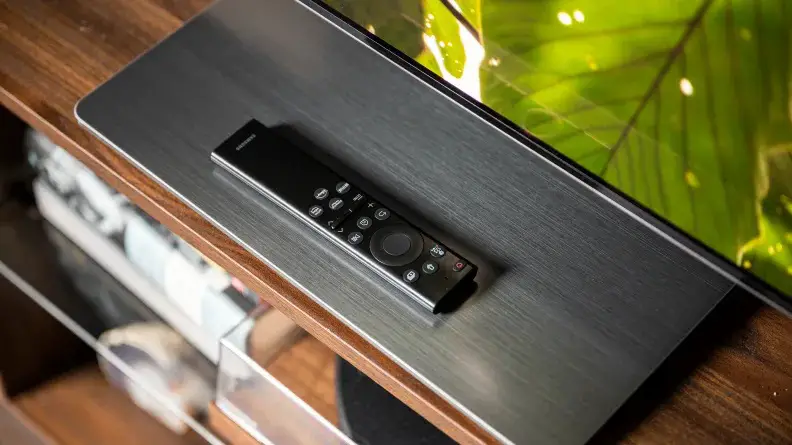
For more reviews you can check our dedicated 4K QD-OLED TV reviews list or even look at our Product Reviews Table where you can find the brand and specific product you are looking for.
Cheapest Places to Buy :
*We are a reader-supported website. When you buy through links on our site, we may earn a small affiliate commission at no extra cost to you. Home Media Entertainment does not accept money for reviews.*
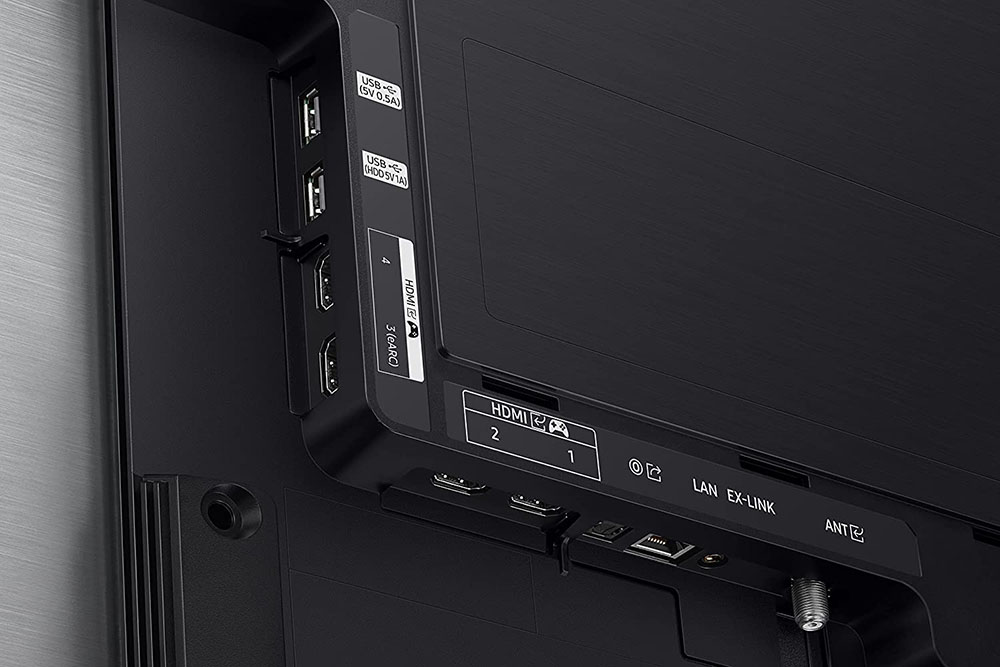
Very thoroughly written. I have a 55-inch Samsung smart tv I bought in 2017 that still holds up to this day and I enjoy it very much. I do like the tizen os but I am not convinced about its new full screen implementation. But I see that everyone is going the same route so not much of a choice there, huh?
Hey Wes. Indeed after Google TV, both webOS and Tizen have gone the same way. I was skeptical at first but after a while it becomes better and it doesn’t bother me so much anymore. But surely if you like the bottom screen tiled row it take some time to find your bearings.
Thank you for this very detailed and unbiased review of the Samsung S95B. Actually this is the second time I read about the S95B’s questionable image accuracy. A bit disappointing really but I do get Samsung’s intentions. After all how many people, other than experts, do know how accurate the image is? And this is what Samsung is counting on.
Indeed Dana. Most casual consumers will only see an impressive image and they will decide based on this, not if what you see is actually as it was intended. Hopefully this is not where things are heading in general with premium TVs.